Learning how to bake inline hockey skates can seem like a daunting task.
Indeed, when it’s time to elevate one’s game to the next level, a major challenge is comprehending how to bake inline hockey skates effectively.
Finding out how to properly bake inline hockey skates.
Many players have NO idea how this process works. However, mastering this technique separates the casual player from the true roller hockey enthusiast. If you don’t know how to mold your skates for that perfect fit, you’ll never reach peak performance on the rink.
Post-Baking Care for Your Roller Hockey Skates
Caring for your newly baked roller hockey boots is as crucial as the baking process itself.
The first step post-bake involves a cool-down period, which should be done at room temperature to avoid any potential damage from sudden changes in heat.
Maintaining Your Baked Skates
Regular maintenance of your skates can significantly extend their lifespan and keep them performing optimally on the rink.
This includes cleaning debris off wheels, checking bearings regularly, and ensuring laces are not frayed or worn out.
Suitable Storage Advice
Avoid storing freshly baked skates in damp areas or extreme temperatures that could warp their shape over time. Instead opt for a dry place with consistent moderate temperature levels.
Hitting The Rinks Again: What You Need to Know After Baking
I recommend waiting 24 hours after baking before hitting the rinks again. This allows adequate cooling time so you don’t compare baking roller skate experience negatively due to premature use.
As we transition into our next section let’s delve deeper into why manufacturers recommend certain practices when it comes to bakeable roller blades.
Remember each pair of professional roller blades has its unique requirements; understanding these will ensure an optimal fit every single game day.
Understanding Manufacturers’ Recommendations on Baking
If you’re new to the roller hockey game, you might be wondering why manufacturers recommend baking certain types of roller blades but not others.
The reason lies in the construction and materials used in different skates. Some are designed with heat-moldable components that can adapt to your foot’s unique shape when heated, providing a custom fit for enhanced comfort and performance.
Bauer, one of the leading brands in inline skating equipment, provides specific guidelines regarding how to bake their Bauer 1X skates at home safely. They emphasize following these instructions carefully as improper baking could damage your skate or void its warranty.
Differentiating Between Bakeable Rollerblades And Non-Bakeable Ones
Not all rollerblades are suitable for baking, though. Entry-level models often lack this feature due to cost considerations during the manufacturing process.
This doesn’t mean they won’t provide a good fit; it simply means they rely more on traditional methods like breaking-in over time through regular use rather than quick customization via heating.
Skate US offers an informative guide detailing which types of skates typically come with heat molding capabilities if you’re unsure about yours.
FAQs in Relation to How to Bake Inline Hockey Skates
How do you bake inline hockey skates?
Baking inline hockey skates involves heating them in an oven, then wearing them to mold to your feet. Always ensure the skates are heat-moldable and follow manufacturer’s instructions closely.
How do you mold roller hockey skates?
Molding roller hockey skates is achieved through baking or using a hairdryer/heat gun. After heating, wear the skate until it cools for a custom fit.
How do you heat mold on inline hockey skates?
To heat mold inline hockey skates, preheat your oven, place the prepared skate inside for specified time, remove it carefully and put it on till cooled down completely.
What temperature do you bake skates at?
The recommended temperature for baking most brands of roller blades ranges from 175°F to 200°F (80°C – 95°C). Always refer to specific manufacturer guidelines before proceeding.
Conclusion
Mastering how to bake inline hockey skates is a game-changer.
You’ve delved into the basics and understood why some skates are heat-moldable while others aren’t.
The preparation phase became clear – removing wheels and bearings, loosening laces, choosing the right socks, and understanding the insoles’ role.
You’re now equipped with a step-by-step guide to bake your roller blades at home or explore alternatives if needed.
Caring for your newly baked boots won’t be an issue either. You know all about cooling down procedures, storage advice, regular maintenance tips, and proper knee support.
Baking recommendations from manufacturers? Checked!
Acknowledging how comfortable skates can boost your performance on rink by allowing greater control over movements? Absolutely!
World Inline Hockey is here to help you further enhance these skills.
Whether you’re just starting out or aiming to reach new heights in your inline hockey journey, we provide valuable information that will take your passion for this sport beyond boundaries.
Join us today at World Inline Hockey; let’s redefine what it means to play this amazing game together!

